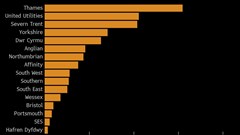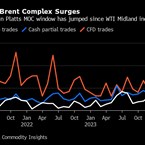Thames Water Bond Haircut Risks Contagion, Barclays Survey Says
(Bloomberg) -- The UK’s water industry may struggle to attract fresh financing should Thames Water’s senior bondholders end up facing losses, according to a survey of investors by Barclays Plc.
Protecting the investment-grade rating of Thames Water’s operating company as well as shielding haircuts for class A bonds is a “systemic” priority for 70% of the survey’s respondents, the London-based bank said in a note Tuesday. A failure of its operating firm would prompt systemic risk for the UK’s water industry, three-quarters of participants said.
Some lenders to Thames Water face losses of as much as 40% if the utility ends up being temporarily nationalized by the UK government, according to contingency plans drawn up by officials. With £16 billion ($20 billion) of debt, it’s the most highly leveraged among peers, and its parent has already defaulted after shareholders refused to stump up the cash it needs.
“Failing to preserve Thames Water’s IG status and exposing the senior opco bondholders to material losses would lead debt investors to question the resilience and the sustainability of the UK water regulatory framework,” said Barclays analysts including Dominic Nash and Peter Crampton in the note.
The firm still needs to find billions of pounds to cover a five-year business plan required by the UK regulator to fix chronic leaks and sewage spills. That mirrors a need for funding across the sector, estimated at £45-£50 billion between 2025 and 2030, Barclays said, based on Moody’s Ratings estimates.
Barclays’s survey was based on nearly 80 responses from credit and equity institutional investors, conducted in the week to April 19.
The risks are keeping Thames Water Utilities’s debt depressed, with its £600 million of 5.125% bonds due 2037 quoted at a spread of around 280 basis points above UK gilts, according to Bloomberg indicative prices. That’s surged in the past two years and spiked to as much as 319 basis points earlier this month.
©2024 Bloomberg L.P.
KEEPING THE ENERGY INDUSTRY CONNECTED
Subscribe to our newsletter and get the best of Energy Connects directly to your inbox each week.
By subscribing, you agree to the processing of your personal data by dmg events as described in the Privacy Policy.
More utilities news

Asian nations are set to dominate global polyolefins capacity additions by 2030
May 01, 2024
Fertiglobe approves $200 million dividend in one of the sector’s highest payouts
May 01, 2024
Barakah One wins ESG financing award for groundbreaking $2.42 billion green refinancing for nuclear energy
Apr 30, 2024
Borouge beats market expectations as Q1 net profit rises by 37% to $273 million
Apr 30, 2024
BHP Mega Bid and $10,000 Copper Expose Mining’s Biggest Problem
Apr 29, 2024
Southeast Asia Heat Wave Shuts Schools, Stokes Power Demand
Apr 28, 2024
Texas Grid Warns of Possible Power Emergency Early Next Week
Apr 26, 2024
Thames Water Crisis Puts £100 Billion UK Investment Plan at Risk
Apr 26, 2024
TechnipFMC reports a $2 billion start to the year with first quarter results surpassing forecasts
Apr 26, 2024
COP29 Climate Summit Countdown Starts With Finance at Forefront
Apr 25, 2024
Why the energy industry is on the cusp of disruptive reinvention
Mar 12, 2024
Chevron helping drive Egypt’s journey to become Africa’s energy powerhouse
Mar 11, 2024
Energy Workforce helps bridge the gender gap in the industry
Mar 08, 2024
EGYPES Climatech champion on a mission to combat climate change
Mar 04, 2024
Fertiglobe’s sustainability journey
Feb 29, 2024
India’s energy sector presents lucrative opportunities for global companies
Jan 31, 2024
Oil India charts the course to ambitious energy growth
Jan 25, 2024
Maritime sector is stepping up to the challenges of decarbonisation
Jan 08, 2024
COP28: turning transition challenges into clean energy opportunities
Dec 08, 2023
Why 2030 is a pivotal year in the race to net zero
Oct 26, 2023Partner content

Ebara Elliott Energy offers a range of products for a sustainable energy economy

Essar outlines how its CBM contribution is bolstering for India’s energy landscape

Positioning petrochemicals market in the emerging circular economy

Navigating markets and creating significant regional opportunities with Spectrum
































